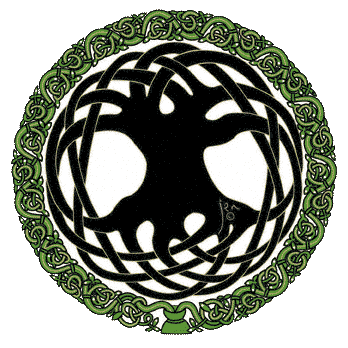| Celts Page 3 
Celtic Christianity While the regions under Roman rule adopted Christianity along with the rest of the Roman empire, unconquered areas of Scotland and Ireland moved from Celtic polytheism to Celtic Christianity which was a major source of missionary work in other parts of Britain and central Europe. This brought the early medieval renaissance of Celtic art between 400 and 1200, developing many of the styles now thought of as typically Celtic, and found through much of Ireland and Britain, including the north-east and far north of Scotland, Orkney and Shetland Islands. This was brought to an end by Roman Catholic and Norman influence, though the Celtic languages and some minor influences of the art continued. Celts Pushed west by Germanic Migration Celts were pushed westwards by successive waves of Germanic invaders, perhaps themselves at times pressured by Huns and Scythians or simply population pressures in their homeland of Scandinavia and Northern Germany. With the fall of the Roman Empire the Celts of Gaul, Iberia and Britannia were "conquered" by tribes speaking Germanic languages. Elsewhere, the Celtic populations were assimilated by others, leaving behind them only a legend and a number of place names such as Bohemia, after the Boii tribe which once lived there, or the Kingdom of Belgium, after the Belgae, a Celtic tribe of Northern Gaul and south-eastern England. Their mythology has been absorbed into the folklore of half a dozen other countries. For instance, the famous Medieval English Arthurian tale of Sir Gawain and the Green Knight is almost certainly partially derived from the medieval Irish text Fled Bricrend (The Feast of Bricriu). Argument rages in the academic world as to whether the Celts in England were mostly wiped out/pushed west as the lack of evidence for influence of the Celts on Anglo-Saxon society suggests, or whether the Teuton migration consisted merely of the social elite and that the genocide was cultural rather than physical due to such relatively few numbers of Anglo-Saxons mixing with the far larger native population, enabled to do so due to the civil strife in Britain after the Roman withdrawal and the unity of the incoming invaders. Some recent DNA studies have suggested that the population of England maintains a predominately ancient British element, equal in most parts to Cornwall and Wales. The general indigenous population of Yorkshire, East Anglia and the Orkney and Shetland Islands are those populations with the least traces of ancient British continuation. Ironically, it may be Viking genetic influence and not Anglo-Saxon which has had a more profound impact on British bloodlines. Celtic Social System The pre-Christian Celts had a well-organized social structure, based on class and kinship, with the religion we call Celtic polytheism. Elected Kings led the tribes, and society was divided into three groups: a warrior aristocracy, an intellectual class including druids, poets, and jurists, and everyone else. Women participated both in warfare and in kingship, and all the offices of high and low kings were filled by election under the system of tanistry, both factors which would confuse Norman writers expecting the feudal principle of primogeniture where the succession goes to the first born son. Little is known of family structure, but Athenaeus in his Deipnosophists, 13.603, claims that "the Celts, in spite of the fact that their women are very beautiful, prefer boys as sexual partners. There are some of them who will regularly go to bed - on those animal skins of theirs with a pair of lovers," implying with a woman and a boy. Celtic Societies Celtic societies were organised around warfare, but this seems to have been more of a sport focussed on raids and hunting rather than organised territorial conquest, drawing obvious comparisons to warfare among Native Americans prior to European contact. This was the age of Hillforts and duns, but there was apparently no urbanization. Celtic Religous Patterns Although Celtic gods varied from region to region and tribe to tribe, the Celtic religion had some patterns. For example like Mediterranean cultures most early Celts worshipped in sacred groves. This was once postulated to have occured because of Celts trading with Mediterranean cultures; however, evidence from Hallstatt era finds show that the earliest Celts practiced this before such trade took place. More reasonably, it is a byproduct of most primitive religion to worship in such a way. However, La Tene Celts also built temples of varying size and shape, though they still usually maintained sacred trees, or votive pools. Worship was, in this way, defered to temples, when they were available. Numerous temples were converted by the Romans, and with little difficulty; the design was rather similar to Roman temples, as they were both highly influenced by the Greeks, architecturally speaking. Druids Their druid postitions vary; a druid is not always a priest. Druids are any members of a Celtic society who had what we would view today as a college education. The most educated druids were usually doctors, priests, and heralds, as these occupations required the most memorization and skill for their practices.
Info found on Crystalinks.com For Next Page 
|  Free Forum Hosting
Free Forum Hosting